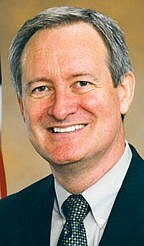Crafting new farm bill starts with listening to Idaho farmers, ranchers
Bonners Ferry Herald | UPDATED 1 year, 9 months AGO
As many of the programs authorized in the 2018 Farm Bill expire this year, it is time to write a new Farm Bill. Throughout my time in Congress, I have greatly valued opportunities to work for Idahoans to help shape past Farm Bills to ensure federal farm policy best empowers Idaho production. I am looking to Idaho agriculture to once again share your input on what federal farm policies are working and what policies need fine-tuning in the upcoming Farm Bill discussions.
Agriculture production is central in Idaho, where farmers and ranchers put food on our tables, support local jobs and meet an ever-increasing demand for food. Idaho’s 25,000 farms and ranches maintain Idaho’s ranking in the top ten in the nation in 30 agricultural commodities, according to the Idaho State Department of Agriculture (ISDA) statistics. Further, the ISDA reports, agriculture and food processing generate 17 percent of Idaho’s total economic output in sales, accounting for nearly $20 billion in agriculture cash recipes and processed food and beverage sales in 2020.
As food demands increase with rising world populations, we continue to ask farmers and ranchers to essentially produce more with less. They are asked to meet these demands while pressure on land and water use, input costs, inflation impacts, the farm labor crisis, regulatory changes and other requirements are also escalating. The Farm Bill provides important tools producers in Idaho and across the nation need as they continue to face a challenging farm economy while ensuring the continuation of important research, promotion and conservation programs.
I have often noted that the Farm Bill contains a wide swath of federal policy far beyond what is considered traditional agricultural commodity programs. The Farm Bill includes federal nutrition, conservation, rural development, energy, world market access, forestry, specialty crops, organics and many other programs. For example:
Commodity programs provide a safety net for U.S. agriculture producers, enabling them to remain competitive in an expanding global market as they continue to feed the world’s hungry. The next Farm Bill must continue to make wise use of taxpayer dollars while providing an appropriate safety net and risk management tools to enable Idaho farmers and ranchers to weather difficult times.
Conservation programs’ incentives, rather than mandates, are the best way to achieve environmental results on private land and contribute more to enhancing our environment than any other policy. I have been proud to help shape these programs, which enable landowners to meet environmental goals that benefit everyone.
Forestry and Energy programs advance energy independence while assisting with the protection, conservation, restoration and renewable energy development on forest lands. As agriculture contributes to renewable energy production, it also plays a key part in effective public lands, grazing, wildlife, wildfire mitigation and suppression policies.
Trade programs that provide market assistance to reach consumers around the world are also of significant interest, as ISDA reports more than $2.3 billion of Idaho’s produce, grains, meats, dairy and seeds are sold worldwide. We have opportunities to further knock down barriers to accessing more world markets for Idaho products, such as building on Japan’s easing of restrictions on imports of American beef.
Private agricultural markets, such as beef processing, marketing and competition, are also often subjects of Farm Bill discussions. Throughout, I will continue to work with Idaho cattle producers and stand against policies that would allow government intervention into private markets that may cause adverse and unintended consequences.
Additionally, while the Farm Bill is not intended to address the agriculture labor shortage, the need to address the shortage as soon as possible in separate legislation remains critical. A solution can be reached if we focus on achieving an outcome intended to meet the long-term needs of the agricultural industry.
These are a few highlights of the many sections and likely discussions about this important, comprehensive law. I will continue to work for Idaho producers and others as Farm Bill reauthorization discussions take shape. I encourage those interested in these issues to contact me with your views as Congress begins the process of writing the next Farm Bill.
Mike Crapo represents Idaho’s First Congressional District in the U.S. Senate. He can be reached at crapo.senate.gov.



